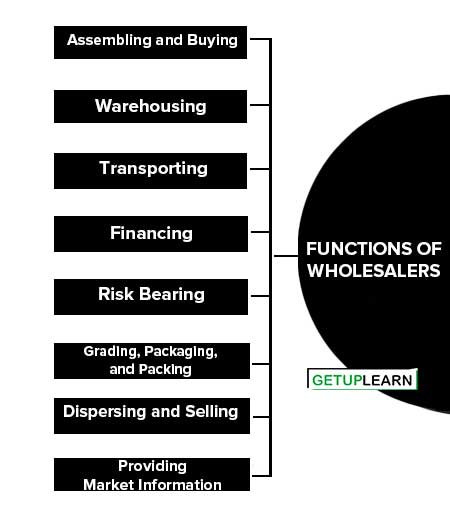Table of Contents
Functions of Wholesalers
In the process of marketing goods, the wholesalers perform a number of functions. Discussed the functions of wholesalers given below:
- Assembling and Buying
- Warehousing
- Transporting
- Financing
- Risk Bearing
- Grading, Packaging, and Packing
- Dispersing and Selling
- Providing Market Information

Assembling and Buying
The wholesaler assembles or collects a small lot of scattered agricultural production for economic bulk buying. At the same time, they select the manufacturers to place orders on them and make special purchases in case of seasonal products.
Warehousing
Wholesalers hold inventories as there is always a gap between time periods of production and consumption. In order to reduce risks and inventory costs, this warehousing by wholesalers helps the retailers and the producers a lot.
Transporting
Wholesalers can provide quicker delivery to buyers as they are closer to them. This transportation is done either through their own fleet or through hired common carriers. In the activities of assembling, warehousing, and resale the wholesalers undertake the transportation tasks.
Financing
By granting credit to the customers and financing the suppliers by ordering early and paying bills on time the wholesalers undertake financing tasks.
Risk Bearing
Risks are unavoidable in business and need to be borne and shifted. The risks of loss of change in prices, damage, quality deterioration, pilferage, theft, fire, and the like are borne by the wholesalers. They also bear the risks of underpayment or non-payment by retailers.
Grading, Packaging, and Packing
Grading is an important task of wholesalers wherein the stocks are sorted in terms of different sizes, qualities, shapes, and so on. To meet the small lot requirements of the retailers bulk breaking is done and also repacks for the consumers as per the retailer’s order.
Dispersing and Selling
Wholesaler’s sales forces help the manufacturers to reach small business customers at a relatively low cost. The assembled goods and the stocked ones are meant for dispersing and selling. The retailers buy from the wholesalers.
Providing Market Information
Information regarding competitors’ activities, new products, price developments, and so on is supplied by wholesalers to suppliers and customers.
Latest Trends in Wholesaling
Manufacturers often have some issues or problems with wholesalers for which they bypass their services or replace them with better and more efficient ones.
Major complaints against the wholesalers are: manufacturer’s product lines are not aggressively promoted by the wholesalers; customer’s orders are not filled fast enough as the wholesalers do not carry enough stock; up-to-date market, customer and competitive information not provided by wholesalers; high-caliber managers are not hired and they charge too much for their services.
Even direct-buying programs were designed by large manufacturers and retailers for which the wholesalers had a significant decline. In order to meet the changing needs of the customers and suppliers the successful wholesalers had to adapt their services and add value to them.
The constant changes and the latest trends compelled wholesalers to reduce operating costs and invest in advanced materials, handling technology, information systems, and the internet.
With the latest trend of increase in prices and absorbing competent suppliers based on cost and quality, the position of wholesaling industry is at risk. The manufacturers still remain strong by controlling their intermediaries and owning them too. Some of the major trends in wholesaling are discussed as follows:
- The distribution between large retailers and large wholesalers continues to blur. While many retailers now operate formats such as wholesale clubs and super-centers that perform many wholesale functions, many large wholesalers are setting up their own retailing operations
For example, a majority of its business derived from supplying grocery products to independent grocery retailers.
- Wholesalers will continue to increase the services they provide to retailers retail pricing, cooperative advertising, marketing and management information reports, accounting services, online transactions, and others.
- Both the recently sluggish economy and the demand for increased services have put a squeeze on wholesaler profits. However, the increased use of computerized, automated, and Web-based systems will help wholesalers contain the costs of ordering, shipping, and inventory holding, thus boosting their productivity.
What are the functions of wholesalers?
These are the functions of wholesalers: Assembling and Buying, Warehousing, Transporting, Financing, Risk Bearing, Grading, Packaging, and Packing, Dispersing, and Selling, and Providing Market Information.
